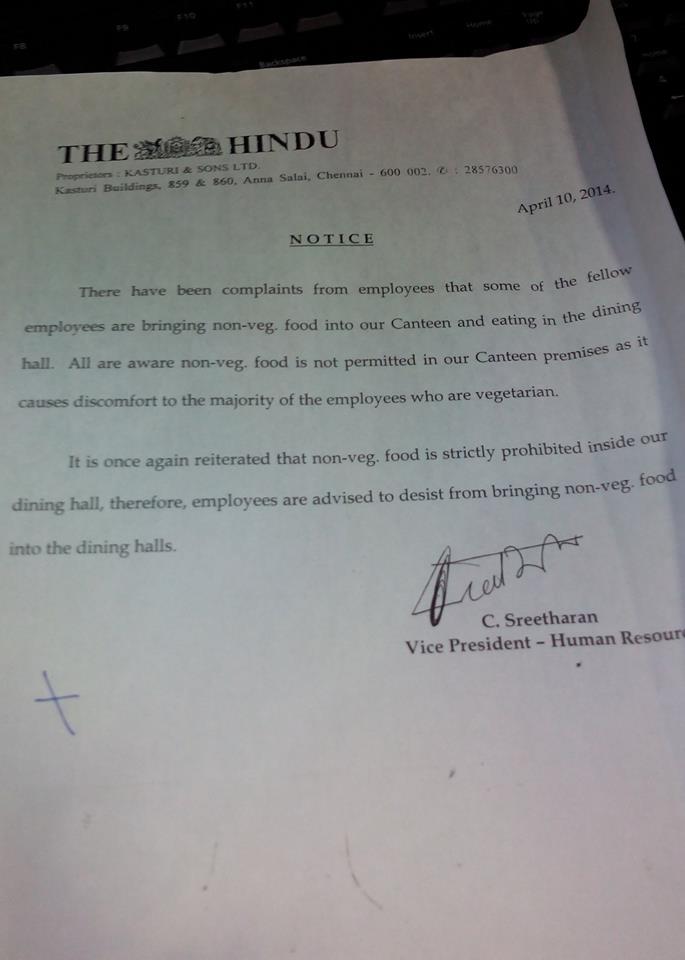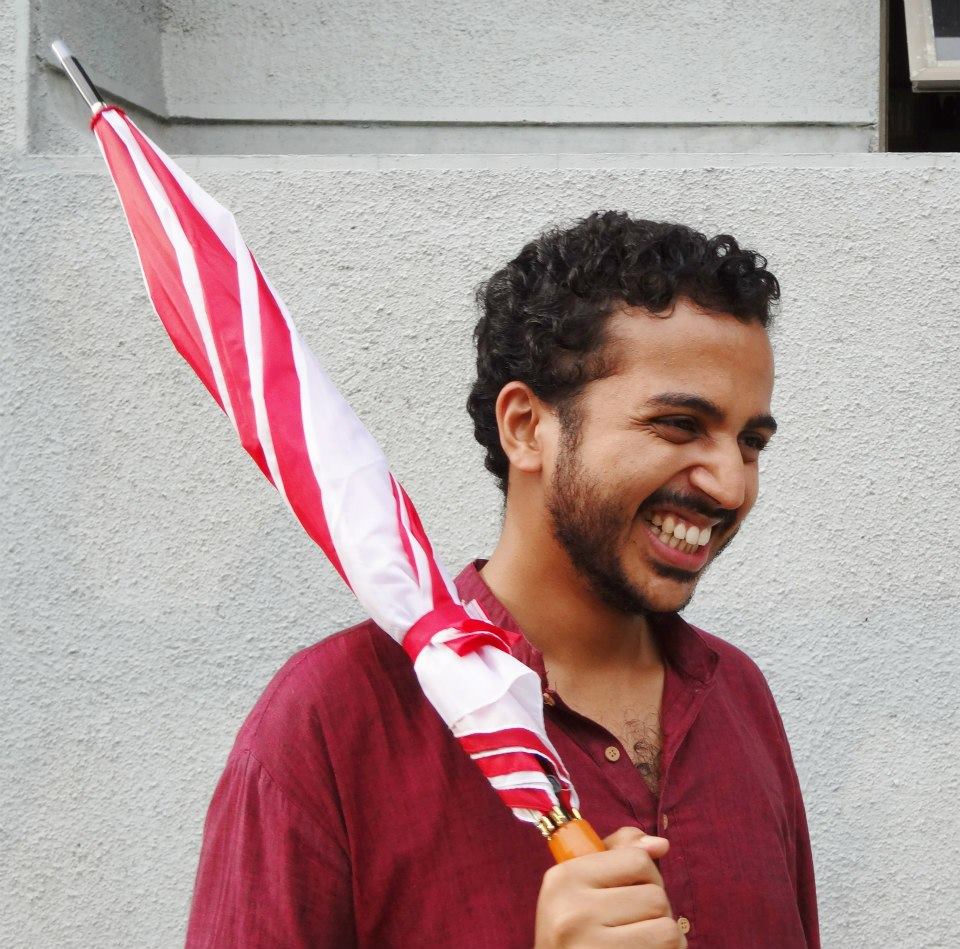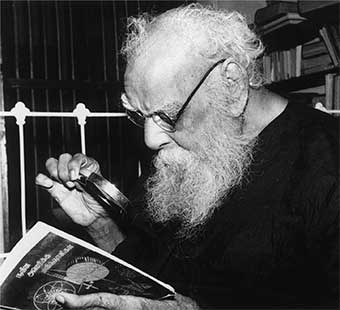N. Sukumar and Shailaja Menon
In an internal circular, leaked on the social media, The Hindu, one of India’s leading newspapers, banned the consumption of non-vegetarian food in its canteen1. The circular precisely points out that “All are aware that non-veg food causes discomfort to the majority of the employees who are vegetarian.” Hence, the unwritten rule is that certain foods are taboo and not to be consumed in a communitarian set up like a canteen. This assumption leads to a series of questions: Who made these ‘unwritten’ rules? For whom? Who constitutes this ‘majority’? No prizes for guessing the answer. Obviously, the rule must have been created, socially and culturally legitimized by a socially superior (Dvija status) entity, so much so that down the ages, it is being strictly enforced. One should also ponder about the ‘surveillance’ over such a routine issue about what people consume in the canteen.

It can be argued that what to consume, where and how is the internal matter of any organization. However, when an institution which enjoys undisputed credibility like ‘The Hindu’ enforces such retrograde values, it is indeed food for thought. Newspapers like ‘The Hindu’ were in the vanguard of the anti-colonial struggle and for generations of readers, it has built a legacy of trust. While discussing the above-mentioned circular in the social media, some journalist friends highlighted the ‘freedom-fighting’ credentials of the newspaper. Is the idea of freedom limited to a political transfer of power, or does it also include cultural and social freedom? If eating certain kinds of ‘impure’ foods is part of any individual’s habitus, why should they be denied? The same newspaper reported that ’70 percent of Hyderabadis are Non-Vegetatians’2. Do we conclude that Hyderabad is a ‘tamsik’ space dominated by the meat eating ‘mlechhas’ like Muslims, Christians and Dalits? The same report mentions the ‘Greening of meat and poultry processing Sector in India’ and MoUs being signed by the National Meat & Poultry Processing Board with the Sri Venkateshwara University, Tirupati, and the National Research Centre on Meat, Hyderabad. Interestingly, sale and consumption of meat is banned in Tirumala to safeguard its Brahmanical purity but they have no qualms earning profits from the meat industry.
No wonder, emotions flew thick and fast over the social media- ranging from not to ‘communalize’ or ‘personalize’ an internal issue to vegetarianism is being kind to animals. On the surface, these are indeed very laudable sentiments but as many non-Hindus have discovered to their peril, the politics over food in India has left behind a bloody trail3.
Cultural Politics and Food
In contemporary times, Babasaheb Ambedkar radically engaged with the issue over food, especially beef-eating to unravel the nefarious nexus behind untouchability and pollution. In his seminal work, “The Untouchables: Who Were They and Why They Became Untouchables”, he re-visits the shastraic4 literature regarding the injunctions on what is kosher food. Eating habits and patterns are specific to culture, availability of resources and geographical location. However, to categorise food as ‘satvik, rajsik and tamsik’ is a sign of warped minds who wish to perpetuate a false notion of purity. A person living near the seashore has to depend on the sea food for survival. In many cold regions, people preserve non-vegetarian food (as dry meat) as the supply diminishes under extremely wintry conditions. Many poor Dalits use similar techniques in order to ensure a regular food supply. Should we consider them as lesser human beings as they do not cook fresh vegetarian food, without spices, onion or garlic thrice a day5?
A culture, which devotes a huge amount of time to the idea of food, cooking processes, ingredients, musing over the purity or the lack of it would require a steady supply of socially and culturally constructed ‘pure’6 bodies to stoke the kitchen fires. This is a reflection of the prevalent Brahmanical Patriarchy which has imprisoned women’s selves to the kitchen.
The ‘national’ airline, Air India offers different categories of meals as listed below7.
• Vegetarian Hindu Meal/Asian Vegetarian/Hindu Vegetarian
• Baby Meal/Infant Food (Vegetarian/Non-Vegetarian)
• Bland Meal (Vegetarian/Non-Vegetarian)
• Child Meal (Vegetarian/Non-Vegetarian)
• Diabetic Meal (Vegetarian/Non-Vegetarian)
• Fruit Platter Meal
• Gluten Intolerant Meal (Vegetarian/Non-Vegetarian)Hindu Meal
• Kosher Meal
• Low Calorie Meal (Vegetarian/Non-Vegetarian)
• Low Fat Meal (Vegetarian/Non-Vegetarian)
• Low Salt Meal (Vegetarian/Non-Vegetarian)
• Moslem Meal
• Low Lactose Meal (Vegetarian/Non-Vegetarian)
• Vegetarian Raw Meal
• Seafood Meal – (only in first & executive classes)
• Special Meal –(needs to be specified)
• Vegan Meal – (vegetarian meal without dairy products)
• Jain Meal – (vegetarian meal without roots & tubers)
• Lacto-Ovo Meal (vegetarian meal with dairy products & eggs)
• Vegetarian Oriental Meal
The exhaustive list provides ample evidence that our food choices reflect our religious and caste identities. The menu does not include the ‘worst’ forms of dietary taboos, beef and pork. In many campuses across the country – to name a few, Hyderabad Central University, Osmania University and Jawaharlal Nehru University – students have agitated to reclaim their right to all kinds of food, including beef and pork.

The Casteist Media
The media is supposed to be the fourth pillar of democracy, which holds up a mirror on the prevailing inequities and unfreedoms in society. However, the media itself has been hijacked by the twice born, masculine intelligentsia which has wilfully turned a blind eye to the politics of presence. In the first-ever statistical analysis of its kind, a survey of the social profile of more than 300 senior journalists in 37 Hindi and English newspapers and television channels in the capital has found that “Hindu upper caste men”, who form eight per cent of the country’s population – hold 71 per cent of the top jobs in the national media. Women, non-upper castes, and Muslims are grossly under-represented in relation to their share in the population.
The survey notes that Dalits and Adivasis “are conspicuous by their absence among the decision-makers. Not even one of the 315 key decision-makers belonged to the Scheduled Castes or Scheduled Tribes.” The survey was designed and executed by Anil Chamaria, freelance journalist, Jitendra Kumar from the Media Study Group and Yogendra Yadav, senior fellow at the Centre for the Study of Developing Societies (CSDS).
If men and women are taken together, the share of upper caste Hindus or ‘dwijas’ in the upper echelons of the media is 85 per cent. These castes account for 16 per cent of the national population. Brahmins alone, the survey found, hold 49 per cent of the top jobs in national journalism. If non-‘dwija’ forward castes like Marathas, Patels, Jats and Reddys are added, the total forward caste share stands at 88 per cent8.
The media’s failure to recruit Dalits is a betrayal of the constitutional guarantees of equality and fraternity. As noted by Robin Jeffery, there were almost none in 1992, and there are almost none today: Stories from the lives of close to 25 per cent of Indians (Scheduled Castes and Scheduled Tribes) are unlikely to be known – much less broadcast or written about, unless of course, the stories are about squalor and violence. An analyst once summed up the treatment of African-American and Hispanic issues in the American media: such people “rarely travel, eat or get married,” if all you knew about them was what you learned from the media.
Is it a calamity that Scheduled Castes and Scheduled Tribes are almost completely absent from newspapers and television? Of course it is. It is evident that the Constitution is not being lived up to. The Constitution promises “equality” and “fraternity.” There’s something deficient about “equality” if a quarter of the population is missing from the Fourth Estate. And it’s hard to fraternise – to practise fraternity – with people who aren’t there9.
No wonder that the majoritarian views dominate to create a ‘laxman-rekha’ over spaces where there is a limited possibility of fraternizing. It is utopian to imagine that the ‘polluted’ people from these excluded communities will ever enjoy the right of entry into the hallowed portals of the media boardrooms. The only space where such hoi polloi can congregate is the humble canteen where their food choices are considered ‘dirty’ and stigmatized by the others.
~
Notes
[1] The Hindu Circular for its Employees, April 10, 2014
[2] http://www.thehindu.com/news/cities/Hyderabad/70-per-cent-of-hyderabadis-are-nonvegetarians/article5737358.ece, Accessed on 17/04/2014, 12.10 am.
[3] Dalit Lynching at Dulina: Cow – Protection, Caste and Communalism, http://www.pudr.org/sites/default/files/pdfs/jhajhar.pdf, Accessed on 17/04/2014, 12.30 am
[4] For further details refer, D.N. Jha, The Myth of the Holy Cow, Matrix Books, New Delhi, 2001
[5] A Graphic Illustration of the Injunctions According to the Hindu Shastras is available on http://www.hindujagruti.org/hinduism/knowledge/article/why-does-hindu-dharma-prohibit-consumption-of-non-vegetarian-food.html. Accessed on 16/04/2014, 11.30 pm
[6] A Woman must be ritually pure to cook in Hindu households.. For details refer, http://www.mahavidya.ca/wp-content/uploads/2008/06/mutter-veitch-tiana-food-in-hinduism.pdf, Accessed 17/04/2014, 12.40 am
[7] http://www.airindia.com/inflight-experience.htm, Accessed on 17/04/2014, 11.30 pm
[8] http://www.hindu.com/2006/06/05/stories/2006060504981400.htm, Accessed on 17/04/2014, 11 pm
[9] Robin Jeffery, “Missing from the Indian Newsroom”, April 9, 2012 00:29 IST, http://www.thehindu.com/opinion/lead/missing-from-the-indian-newsroom/article3294285.ece, Accessed on 17/04/2014, 11.10 pm
~~~
N. Sukumar teaches Political Science at Delhi University. (suku69@yahoo.com)
Shailaja Menon teaches History at the School of Liberal Studies, Ambedkar University, Delhi. (shailaja@aud.ac.in)
Cartoon by Unnamati Syama Sundar.
Picture courtesy: Dalit Camera.










